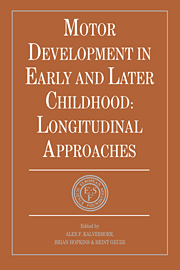Book contents
- Frontmatter
- Contents
- List of contributors
- Foreword
- Preface
- SETTING THE SCENE
- SECTION I BIOLOGICAL BASIS OF MOTOR DEVELOPMENT
- SECTION II DEVELOPMENT OF BODY POSTURE AND GOAL-DIRECTED REACHING
- SECTION III MOTOR DEVELOPMENT, EARLY COMMUNICATION AND COGNITION
- SECTION IV ACQUISITION OF SKILLS
- 12 Individual patterns of tool use by infants
- 13 Tool use, hand cooperation and the development of object manipulation in human and non-human primates
- 14 Handwriting: a developmental perspective
- 15 Development of children's writing performance: some educational implications
- SECTION V MOTOR DEVELOPMENT AND HANDICAP
- SECTION VI METHODOLOGICAL AND CONCEPTUAL CONSIDERATIONS
- Epilogue: description versus explanation
- Index
14 - Handwriting: a developmental perspective
from SECTION IV - ACQUISITION OF SKILLS
Published online by Cambridge University Press: 05 May 2010
- Frontmatter
- Contents
- List of contributors
- Foreword
- Preface
- SETTING THE SCENE
- SECTION I BIOLOGICAL BASIS OF MOTOR DEVELOPMENT
- SECTION II DEVELOPMENT OF BODY POSTURE AND GOAL-DIRECTED REACHING
- SECTION III MOTOR DEVELOPMENT, EARLY COMMUNICATION AND COGNITION
- SECTION IV ACQUISITION OF SKILLS
- 12 Individual patterns of tool use by infants
- 13 Tool use, hand cooperation and the development of object manipulation in human and non-human primates
- 14 Handwriting: a developmental perspective
- 15 Development of children's writing performance: some educational implications
- SECTION V MOTOR DEVELOPMENT AND HANDICAP
- SECTION VI METHODOLOGICAL AND CONCEPTUAL CONSIDERATIONS
- Epilogue: description versus explanation
- Index
Summary
FROM ARCHAEOLOGY TOWARDS A FLOW CHART OF HANDWRITING
The acquisition of speech is unique to humans, and the usage of an extensive repertoire of expressive facial movements and gestural patterns is also reserved for a quite small segment of the Ordo Naturis (Nespoulous, Perron & Lecours, 1986). The use of artifacts to communicate feelings and meanings to members of the group is perhaps an almost exclusive expedient of Homo sapiens. About 35 000 years ago humans began, for the first time, to create symbols of themselves, of the animals around them, and perhaps of the passage of time (Putman, 1989). Although it took a further 25 000 years for the first carved symbols that form the origin of modern handwriting to appear, it might be argued that the skill for manipulating chisels and pencils to code verbal information has its roots within the need and the craftmanship of palaeolithic humans to manipulate and represent their physical and social world (Milone, 1984). If the necessary conditions for the evolution of handwriting are analysed, it may be seen that at least three indispensable requirements have to be fulfilled: the motoric capacity for the production of ‘written’ signs; craftmanship to produce permanent materials to ‘write’ upon, such as pottery (Egypt, Mesopotamia and China) and wood (the New World); and a social organization for which the long-term storage of information is profitable. The latter condition is found among the ancient Sumerians, who invented hieroglyphics, and in the trade-faring society of the Phoenicians, who can be credited with the development and distribution of an alphabetical system in the ancient world (Milone, 1984).
- Type
- Chapter
- Information
- Motor Development in Early and Later ChildhoodLongitudinal Approaches, pp. 217 - 228Publisher: Cambridge University PressPrint publication year: 1993
- 6
- Cited by



